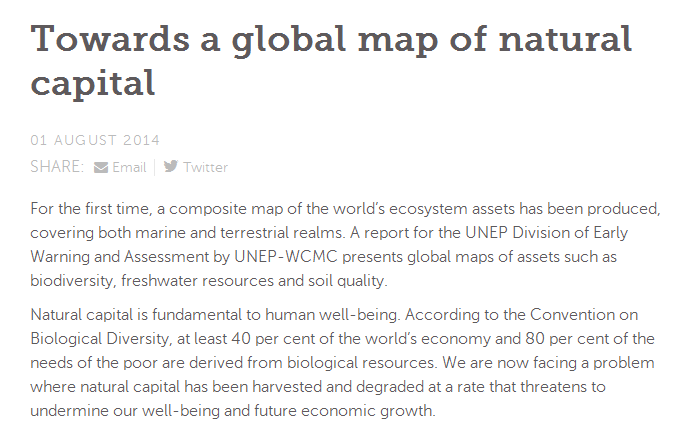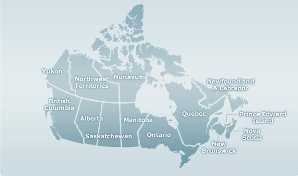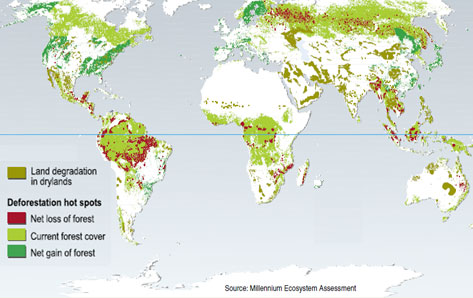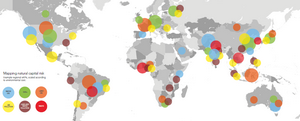Natural Capital: Difference between revisions
Siterunner (talk | contribs) |
Siterunner (talk | contribs) |
||
| Line 196: | Line 196: | ||
the need for major adaptation efforts. | the need for major adaptation efforts. | ||
• Put a sufficiently high price on carbon and deliver the G-20 commitment to phase out fossil fuel subsidies, using these funds to contribute to the several hundred billion US dollars per year needed to scale up investments in renewable energy. | |||
3. Creating an efficiency revolution | 3. Creating an efficiency revolution | ||
Revision as of 17:05, 6 March 2015
○ ○ ○ ○
Natural Capital
- Sustainable Development Goals (SDGs) v GDP as measurement of 'progress'
- http://www.phys.org/news/2014-01-dethrone-gdp-national-success.html#inlRlv
- http://www.naturalcapitaldeclaration.org/
- http://www.naturalcapitaldeclaration.org/2012/08/global-footprint-network-supports-ncd/
- Ecological Footprint
- http://www.worlddialogue.org/content.php?id=512
Natural Capital (financing)
- Valuing natural capital systems +/- ecosystem services - http://www.phys.org/news/2014-05-environmental.html
- http://www.worldbank.org/en/news/2012/06/20/massive-show-support-action-natural-capital-accounting-rio-summit
○ ○ ○ ○
- (FB) https://www.facebook.com/pages/Natural-Capital-Initiative/132253866809725
- http://www.naturalcapitalinitiative.org.uk/links
- http://www.naturalcapitalinitiative.org.uk/news/
Accounting for Nature
"The question that accounting answers is: did this business maintain, create or deplete value over a particular time period (i.e. is the capital stock better off, worse or unchanged)? This is an important question to ask because we can see that, globally, we are depleting the natural capital stock at an alarming rate. You might think no-one would run their business on the basis of capital depletion and yet collectively we do because, economically, nature is invisible; it is not priced...
"Valuing things is not easy. We are beset with questions like: is value the same as price; value to whom; market price or replacement cost; present value of discounted cash flow, but at what rate? This is for things that we often assume are easy to value. When we try to value nature further challenges emerge.
"There isn’t space here to go into all of the challenges of valuation, but let’s just touch on a few. A good place to start is with the questions: should we put a monetary figure on nature; and, if so, what would we be valuing?
"There is also a question: does nature only have value in a human-centric way; does it not have intrinsic value as well? If there is an ecosystem somewhere that is not immediately linked to human benefit, is it worthless?
"But almost more importantly, if we think of a progression from qualitative review of natural capital to a quantitative assessment to a financial valuation, increasingly elements are left out, not because they are irrelevant or immaterial but because they can’t be quantified or valued. Paradoxically one could conceivably end up with a value that captures nothing one finds valuable. How, for example, do we capture the complexity and inter-connectivity of systems fundamental to our natural world? How do we value our mother or father? Surely the real value exists in the emotion we feel for them; how do you put a monetary value that?
"Developing from this there is an argument, heard loud and strong in civil society, which says we should not put a value on nature; that that simply commoditises it and diminishes its true value. Just because something is not quantifiable does not mean it is not important. A position that privileges what can be measured is open to placing quantity above quality; and most of us would question that arrangement. We have to take notice of the things we cannot measure. You can’t really measure truth or justice or freedom. Such an argument can be located within the wider debate of the extent to which we are creating a market society that puts everything up for sale and asks where the limits of that should be. An exposition of some of the thinking behind such a position is Michael Sandel’s What Money Can’t Buy.
As Sandel concludes: "The question of markets is really a question about how we want to live together. Do we want a society where everything is up for sale? Or are there certain moral and civic goods that markets do not honour and money cannot buy?"
○ ○ ○ ○
Natural Capital Mapping
Natural Capital (Mapping / Assessment app)
Google Outreach links with Suzuki Foundation / Prototype NatCap Mapping - Canada (video)
○ ○ ○ ○
- http://www.davidsuzuki.org/publications/downloads/2011/REPORT--BC_natcap_policy_review_web.pdf
- http://www.davidsuzuki.org/issues/wildlife-habitat/projects/natural-capital/
- http://www.davidsuzuki.org/issues/wildlife-habitat/projects/natural-capital/what-is-natural-capital/
- http://www.davidsuzuki.org/issues/wildlife-habitat/projects/natural-capital/putting-natural-capital-on-the-map/
○ ○ ○ ○
Millennium Ecosystem Assessment
United Nations Environment Programme / Division of Early Warning and Assessment
United Nations World Conservation Monitoring Centre
○ ○ ○ ○
Toward a Global Map of Natural Capital / UN
The concept of natural capital, which has its theoretical origins in the environmental economics of the 1990s, has experienced increased interest following the publication of the Millennium Ecosystem Assessment and the development of the ecosystem services approach.
In recent decades we have learned more about the ways in which nature provides vital life-support functions upon which we depend for our survival. The problem we face is that natural capital has been harvested or degraded at a rate that threatens to undermine both well-being and future economic growth (UNEP, 2007). Natural capital may be transformed to other types of capital, but even manufactured capital is formed from the resources found in nature.
The growing recognition that the environment plays a fundamental role in determining global economic outputs and human well-being has led to a range of responses, one of which is the integration of the value of natural capital into policy and decision making. As a consequence, governments around the world are grappling with how to better measure the success of their economies. Work is being carried out by the World Bank, OECD, UN, EEA and others on developing methods to incorporate natural capital into national accounts.
○ ○ ○ ○
Earth Systems Monitoring from Space
NASA Earth Observing System Data and Information System -- Maps
NASA Earth Sciences Invites Public to Join In
Earth Science Research from Space ○ ○ 'New Space' Earth Monitoring with Micro-satellites ○ ○ Planet Labs
Global Fishing Watch ○ ○ Global Forest Watch ○ ○ Google Earth Outreach ○ ○ Rebecca Moore and the Google Outreach team
New Definitions of National Security ↔ Environmental Security
○ ○ ○ ○ ○ ○ ○ ○ ○ ○ ○ ○ ○ ○ ○ ○ ○ ○ ○ ○ ○ ○ ○ ○ ○ ○ ○ ○ ○ ○ ○ ○ ○ ○ ○ ○ ○ ○ ○ ○ ○ ○ ○ ○ ○
http://www.teebweb.org/resources/useful-links/
http://www.teebweb.org/areas-of-work/teeb-for-business/
http://www.trucost.com/publications
http://www.teebweb.org/our-publications/teeb-study-reports/business-and-enterprise/
Natural Capital Use Reports
http://www.teebweb.org/our-publications/teeb-study-reports/ecological-and-economic-foundations/
http://www.teebweb.org/our-publications/teeb-study-reports/national-and-international-policy-making/
http://www.teebweb.org/areas-of-work/advancing-natural-capital-accounting/
Data made available, for example, snaphots circa 2013
The majority of unpriced natural capital costs are from greenhouse gas emissions (38%), followed by water use (25%), land use (24%), air pollution (7%), land and water pollution (5%), and waste (1%).
The total unpriced natural capital consumed by the more than 1,000 “global primary production and primary processing region-sectors” amounts to $7.3 trillion a year — 13 percent of 2009 global GDP.
New Visions: Beyond the Old Definitions
New ways to envision sustainable development and growth
Green Concepts and New Eco-nomics
http://www.greenpolicy360.net/mw/images/Global_Sustainability_Resilience_memorandum-2011.pdf
We recommend a dual track approach:
a)emergency solutions now, that begin to stop and reverse negative environmental trends and redress inequalities in the inadequate institutional frameworks within which we operate, and
b)long term structural solutions that gradually change values, institutions and policy frameworks.
We need to support our ability to innovate, adapt, and learn.
1. Reaching a more equitable world
Unequal distribution of the benefits of economic development are at the root of poverty. Despite efforts to address poverty, more than a third of the world’s population still live on less than 2 US dollars per day. This needs our immediate attention.
Environment and development must go hand in hand. We need to:
• Achieve the Millennium Development Goals, in the spirit of the Millennium Declaration, recognising that global sustainability is a precondition of success.
• Adopt a global contract between industrialized and developing countries to scale up investment in approaches that integrate poverty reduction, climate stabilization, and ecosystem stewardship.
2. Managing the climate – energy challenge
We urge governments to agree on global emission reductions guided by science and embedded in ethics and justice. At the same time, the energy needs of the three billion people who lack access to reliable sources of energy need to be fulfilled. Global efforts need to:
• Keep global warming below 2°C, implying a peak in global CO2 emissions no later than 2015 and recognise that even a warming of 2°C carries a very high risk of serious impacts and the need for major adaptation efforts.
• Put a sufficiently high price on carbon and deliver the G-20 commitment to phase out fossil fuel subsidies, using these funds to contribute to the several hundred billion US dollars per year needed to scale up investments in renewable energy.
3. Creating an efficiency revolution
We must transform the way we use energy and materials. In practice this means massive efforts to enhance energy efficiency and resource productivity, avoiding unintended secondary consequences. The “throw away concept” must give way to systematic efforts to develop circular material flows.
We must:
• Introduce strict resource efficiency standards to enable a decoupling of economic growth from resource use.
• Develop new business models, based on radically improved energy and material efficiency.
4. Ensuring affordable food for all
Current food production systems are often unsustainable, inefficient and wasteful, and increasingly threatened by dwindling oil and phosphorus resources, financial speculation, and climate impacts. This is already causing widespread hunger and malnutrition today. We can no longer afford the massive loss of biodiversity and reduction in carbon sinks when ecosystems are converted into cropland. We need to:
• Foster a new agricultural revolution where more food is produced in a sustainable way on current agricultural land and within safe boundaries of water resources.
• Fund appropriate sustainable agricultural technology to deliver significant yield increases on small farms in developing countries.
Priorities for coherent global action
5. Moving beyond green growth
There are compelling reasons to rethink the conventional model of economic development. Tinkering with the economic system that generated the global crises is not enough. Markets and entrepreneurship will be prime drivers of decision making and economic change, but must be complemented by policy frameworks that promote a new industrial metabolism and resource use.
We should:
• Take account of natural capital, ecosystem services and social aspects of progress in all economic decisions and poverty reduction strategies. This requires the development of new welfare indicators that address the shortcomings of GDP as an indicator of growth.
• Reset economic incentives so that innovation is driven by wider societal interests and reaches the large proportion of the global population that is currently not benefitting from these innovations.
6. Reducing human pressures
Consumerism, inefficient resource use and inappropriate technologies are the primary drivers of humanity’s growing impact on the planet. However, population growth also needs attention.
We must:
• Raise public awareness about the impacts of unsustainable consumption and shift away from the prevailing culture of consumerism to sustainability.
• Greatly increase access to reproductive health services, education and credit, aiming at empowering women all over the world. Such measures are important in their own right but will also reduce birth rates.
7. Strengthening earth system governance
The multilateral system must be reformed to cope with the defining challenges of our time, namely transforming humanity’s relationship with the planet and rebuilding trust between people and nations. Global governance must be strengthened to respect planetary boundaries and to support regional, national and local approaches.
We should:
• Develop and strengthen institutions that can integrate the climate, biodiversity and development agendas.
• Explore new institutions that help to address the legitimate interests of future generations.
8. Enacting a new contract between science and society
Filling gaps in our knowledge and deepening our understanding is necessary to find solutions to the challenges of the Anthropocene, and calls for major investments in science. A dialogue with decision-makers and the general public is also an important part of a new contract between science and society.
We need to:
• Launch a major initiative on the earth system research for global sustainability, at a scale similar to those devoted to areas such as space, defence and health, to tap all sources of ingenuity across disciplines and across the globe.
• Scale up our education efforts to increase scientific literacy especially among the young
○ ○ ○ ○ ○ ○ ○ ○ ○ ○ ○ ○ ○ ○ ○ ○ ○ ○ ○ ○ ○ ○ ○ ○ ○ ○ ○ ○ ○ ○ ○ ○ ○ ○ ○ ○ ○ ○ ○ ○ ○ ○ ○ ○ ○ ○ ○ ○ ○ ○ ○
Tags: True-Cost Accounting, True-Cost Pricing, TruCost Reports, Full-Cost Environmental Accounting, Production Cycle, Natural Capital, Sustainability Policies, TEEB Initiative - http://www.teebweb.org/resources/useful-links/









